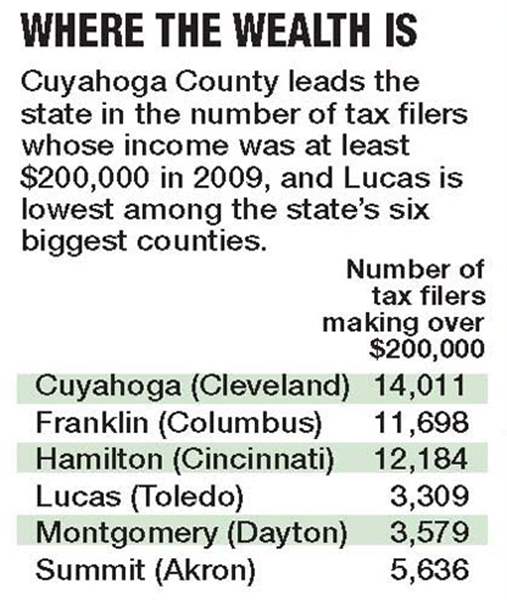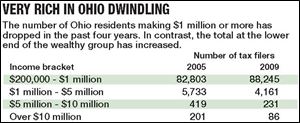
Local high-income ranks fall
Metro Toledo reflects trend in state of Ohio as a whole
4/24/2011
Source: Ohio Department of Taxation
THE BLADE
Buy This Image

Wealthy households have the resources to support community charitable groups as well as to spend at local businesses.
The number of upper-income residents in Lucas County fell significantly in 2008 and 2009, pushing Toledo and its suburbs to last among the six big cities in Ohio in residents with incomes above $200,000. Similar declines occurred statewide, according to the most recent state tax filing figures.
And that results in less money spent at restaurants and stores, hurting the economy and affecting employees at businesses including car dealers, service providers, theaters, and entertainment venues.
Still, the four-county metro Toledo area in 2009 had nearly 4,800 people who made more than $200,000, and the state had more than 88,000.
Ohio had nearly 4,500 tax filers who made more than $1 million in 2009, including 86 pulling in more than $10 million, state Department of Taxation figures show.
"Thirty-three hundred households -- that's nothing to sneeze at," said economist Ken Mayland of ClearView Economics in suburban Cleveland, referring to the Lucas County upper-income number. "People who have incomes of $200,000, they are supporting the fine restaurants, for example.
"Take Rockwell's [restaurant] in Toledo. I've been to steak places all over the country. It is one of the best. But to support a piece of beef like that, you better have a big income," he said.
"That goes for the rest of the community. You're only going to have clusters of high-end consumer businesses and services, jewelry stores and the like, if you have higher-income people."
Mark Zyndorf, a Toledo businessman and entrepreneur with an income of more than $200,000 a year, said households at that level usually help the local economy by their spending habits.

Source: Ohio Department of Taxation
"When you have that, you can give back to the art museum, the opera, other charitable things in the community," he said.
For example, Mr. Zyndorf said his wife loves animals and is a big supporter of the local Humane Society. He is a member of the Valentine Theatre board and helps lead fund drives for its support.
"We're big on dining from an entertainment standpoint, and as such we support the local businesses. You live here, you buy things here," he said.
Although higher-income people are better able to withstand economic downturns, "everybody gets hurt" when they occur, and spending goes down, Mr. Zyndorf said.
"Take the Golden Gate [shopping center in Maumee]. I invested a million dollars rehabbing the center. The good news is we haven't lost any tenants, but we spent $1 million and haven't been able to rent one inch of space," he said.
"It doesn't make any difference what bracket you're in, if you've taken a hit, you've got less to spend," he said.
There were four times the number of tax filers making $200,000 or more in Cuyahoga (Cleveland), Hamilton (Cincinnati), and Franklin (Columbus) counties as in Lucas County in 2009, state figures show. Cuyahoga had more than 14,000, Hamilton more than 12,100, and Franklin nearly 11,700.
Those three counties had 40 percent of the upper-income tax filers statewide.

Source: Ohio Department of Taxation
Jon Honeck, a researcher at the Center for Community Solutions, a regional nonprofit public advocacy agency in Cleveland that has studied taxes and tax rates in Ohio, said Lucas County's smaller cluster of high incomes is a reflection of having a smaller metro area.
But at 40 percent total, the overrepresentation of high incomes in Cleveland, Columbus, and Cincinnati is surprising, he said.
In 2009, Cuyahoga County had 11 percent of the state's population but nearly 15 percent of high-income households. Hamilton County had about 10 percent of the population but about 13 percent of the high-income households, and Franklin County had 7 percent of the population but 12 percent of the high-income households.
Lucas County, on the other hand, had 4 percent of Ohio's population but about 3.5 percent of households with incomes of $200,000 or more.
Mr. Mayland, the economist, said large companies are probably the reason for the disparity.
"The only way that you're going to see a lot of large incomes is if you see a lot of large businesses," he said.
"You're going to need a pretty sizable business to support workers that are going to earn at that level, and where are you likely to see large businesses? Well, large cities have large businesses. And they also have your large banks, your retailers, your car dealers, all of which you're probably not going to find in rural Ohio."
The 3,300 upper-income residents in Lucas County represented 2 percent of all tax returns in the county and about 0.7 percent of its population of 463,493 in 2009.
Larry Boyer, executive vice president of Waterford Bank of Sylvania Township, said the declining number of high-income households in Lucas County is troublesome.
"I think we are struggling when you look at the economic numbers," he said.
Per capita income in Lucas County, which was $32,266 in 2007, dropped to $32,191 in 2009, according to the latest federal figures.
"Everything we're seeing is that while there are some signs and a glimmer [of hope] that people are starting to see, it's still a struggle out there when talking to people every day," said Mr. Boyer, whose bank serves upper-income people.
Despite having larger amounts of disposable income, the more affluent still are affected by the economy, he said.
"A lot of those incomes are people who own their own businesses," he explained.
"If business drops, they have to cut down their own salaries. Also, if you're used to making that $300,000 and now you're making $200,000, you are going to cut down on certain things and it makes a difference overall."
Linda Bowyer, a finance professor at the University of Toledo, said determining what the state figures mean is difficult without knowing whether the number of tax filers with $200,000 or more in income are individuals, families, people with small salaries but additional income from stocks or investments, or small-business owners.
George Mokrzan, chief economist for Huntington Bank Private Financial Group in Columbus, said, "A person who has a business and makes $200,000 in income, that's not as good as an individual making that kind of salary."
But state Department of Taxation analysis provided to The Blade for 2008 -- the last year for which complete data exist -- shows nearly six of every 10 tax returns of upper-income filers in Lucas County had wages of $200,000 or more.
The rest, the state said, could reflect income from businesses, stocks, or other investments.
Contact Jon Chavez at: jchavez@theblade.com or at 419-724-6128.